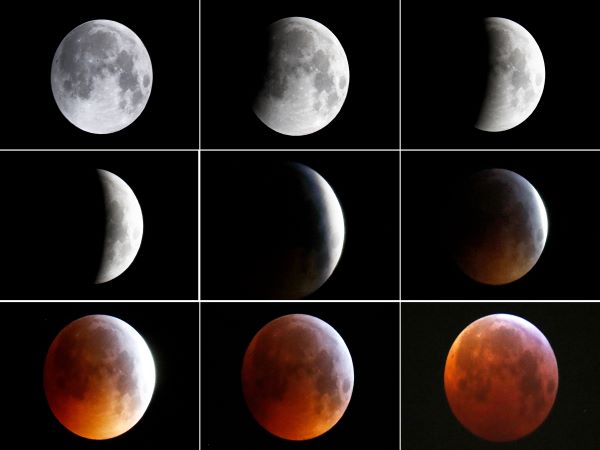How to watch the upcoming ‘Super Flower Blood Moon’ eclipse
The full moon on Wednesday will be the year’s biggest “supermoon” and feature the first total lunar eclipse in more than two years.
During the eclipse, the full moon will pass through the Earth’s shadow. It appears red, known as a “blood moon”, as light is scattered through the Earth’s atmosphere, much like during a sunset.
In addition, the moon will be at perigee, or the closest point to Earth in its orbit, making it appear about 7% larger than normal and 15% brighter or a “super moon,” according to astronomers. May’s full moon is known as the “Flower Moon” since it occurs when spring flowers are in bloom.
The result when taken together is a “Super Flower Blood Moon.”

A combination of nine pictures shows the full moon turning into the “Super Blood Wolf Moon” during a total lunar eclipse in Frankfurt, Germany, January 21, 2019. REUTERS/Kai Pfaffenbach/File Photo
The eclipse will happen in the early morning hours on Wednesday in western North America, with people in Alaska and Hawaii getting the best views. It can also be seen in southern Chile and Argentina. Sky gazers in all of Australia and New Zealand and parts of Southeast Asia can see the eclipse on Wednesday evening.
For stargazers in parts of the world where the event is not visible or obscured by clouds, some observatories will webcast the eclipse.
In one week, a full Moon near its closest point to Earth in its orbit will cross into Earth's shadow. That makes a super lunar eclipse, or if you will, a super blood Moon!
Here's what you need to know: https://t.co/0hpTNKuyTl pic.twitter.com/Mdki7SLMRc
— NASA Moon (@NASAMoon) May 19, 2021
The Griffith Observatory in Los Angeles will stream live views beginning at 1:45 a.m. PT (0845 GMT). The Lowell Observatory will start its broadcast at 2:30 a.m. PT (0930 GMT). The Astronomical Society of South Australia will also broadcast live on Facebook and YouTube starting at 7 p.m. ACST (0930 GMT).
Related Articles
The peak viewing time for the eclipse will be between 4:11 a.m. and 4:26 a.m. PT on the U.S. West Coast or 9:11 p.m. to 9:26 p.m. AEST in Australia (1111 GMT to 1126 GMT), according to the observatories.
The next total lunar eclipse will be May 15-16, 2022.
(Reporting by Lisa Shumaker in Chicago; Editing by Bill Berkrot)

